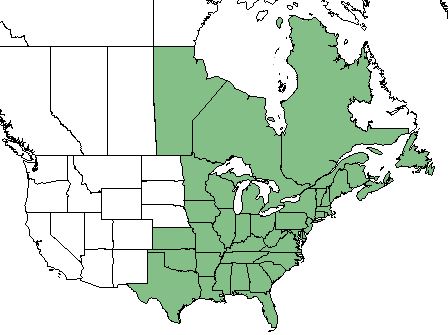Osmunda spectabilis
Common name: royal fern [1], American royal fern [2]
| Osmunda spectabilis | |
|---|---|

| |
| Photo by John Hilty at IllinoisWildflowers.info | |
| Scientific classification | |
| Kingdom: | Plantae |
| Division: | Pteridophyta – Ferns |
| Class: | Filicopsida |
| Order: | Polypodiales |
| Family: | Osmundaceae |
| Genus: | Osmunda |
| Species: | O. spectabilis |
| Binomial name | |
| Osmunda spectabilis L. | |

| |
| Natural range of Osmunda spectabilis from USDA NRCS Plants Database. | |
Contents
Taxonomic Notes
Synonyms: O. regalis Linnaeus var. spectabilis (Willdenow) A. Gray
Varieties: none
Description
O. spectabilis is a perennial forb/herb of the Osmundaceae family native to North America, Canada, and St. Pierre and Miquelon (France). [1]
Distribution
O. spectabilis is found in the eastern half of the United States, the Manitoba, Ontario, and Quebec regions of Canada, and St. Pierre and Miquelon (France). [1]
Ecology
Habitat
O. spectabilis proliferates in bogs, marshes (including tidal), moist forests, floodplains, swamp forests, and other wetlands. [2] Specimens have been collected from moist loamy sand, swamp bank, clearing of floddplain on edge of creek, ditch, swampy woodland, old cypress stump, cypress depression in flatwoods, limestone ridge, cypress gum swamp, pine forest after recent burn, shaded streambank in bottomland hardwood, and edge of mesic woods. [3]
Phenology
O. spectabilis flowers March-May. [4] Pinnately cpd, pinnae with tuft of hair at base; fertile fronds separate and with clusters of cinnamon colored sporangia. [5]
Fire ecology
O. spectabilis is not fire resistant and has a low fire tolerance. [1]
Conservation and Management
O. spectabilis is listed as commercially exploited by the Florida Department of Agriculture & Consumer Services Division of Plant Industry, as threatened by the Iowa Department of Natural Resources Parks Recreation and Preserves Division, and as exploitably vulnerable by the New York Department of Environmental Conservation Division of Land and Forests. [1]
Cultivation and restoration
Photo Gallery
References and notes
- ↑ 1.0 1.1 1.2 1.3 1.4 USDA Plant Database https://plants.usda.gov/core/profile?symbol=OSRES#
- ↑ 2.0 2.1 Weakley, A. S. (2015). Flora of the Southern and Mid-Atlantic States. Chapel Hill, NC, University of North Carolina Herbarium.
- ↑ URL: http://herbarium.bio.fsu.edu. Last accessed: June 2018. Collectors: Loran C. Anderson, Garrett Crow, Dora Engrid Rivera, Roy Komarek, R.K. Godfrey, Robert Lemaire, Andre Clewell, J.P. Gillespie, Richard Mitchell, L.B. Trott, S. W. Leonard, John Nelson, F.C> James, Gary Knight, Elmar Prichard, K. Craddock Burks, K.M. Meyer, A. Townesmith, R.L. Wilbur, Marilyn Gillespie, Samual Jones, John Thieret, P.L. Redfearn, Donna M. Eggers, Delzie Demaree, A.J. SHarp, Robert Britt, Jean Wooten, Sidney McDaniel, H.A. Wahl, Harry Ahles, R.P. Ashworth, James D. Ray, W.J. Cody, Van L. Rens, Scott McCoy, H.B. Parks, Eunice Mitchell, Elizabeth Vandell. States and counties: Florida (Liberty, Leon, Gadsden, Brevard, Indian River, Walton, Citrus, St. Johns, Jackson, Wakulla, Calhoun, Hernando, Hillsborough, Jefferson, Flagler, Santa Rosa, Franklin, Putnam, Holmes, Gulf) Georgia (Grady, Thomas) South Carolina (Berkeley, Beaufort) Mississippi (Harrison, Newton) Alabama (Limestone, Geneva) North Carolina (Durham, Wayne, Chowan, Scotland) Texas (Van Zandt, Nacogdoches) Indiana (Jennings) Pennsylvania (Lycoming) Missouri (Ste. Genevieve) Louisiana (Allen)
- ↑ PanFlora Author: Gil Nelson URL: http://www.gilnelson.com/PanFlora/ Date Accessed: 5/24/18
- ↑ Coile, N. C. (2000). Notes on Florida �s Regulated Plant Index (Rule 5B-40), Botany Contribution No. 38, 3nd edition. Gainesville, Florida, Florida Deaprtment of Agriculture and Consumer Services, Division of Plant Industry.